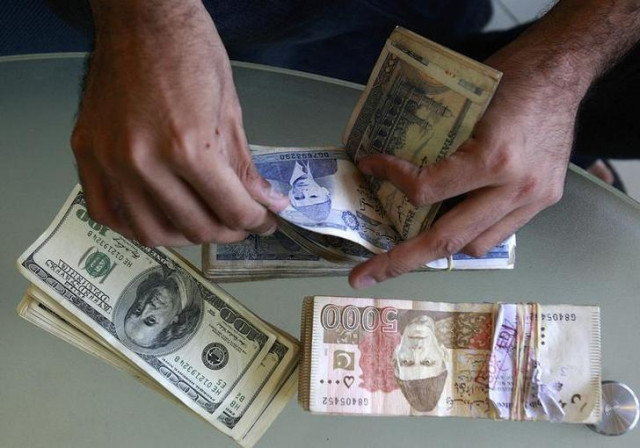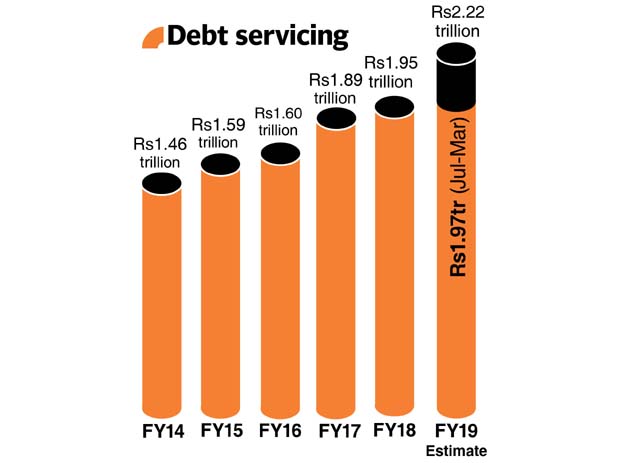Public debt swells to Rs28.6tr by March-end
Major increase of Rs1.2tr in public debt came from 44% rupee depreciation

PHOTO: REUTERS
“The prime objective of public debt management is to ensure that the government’s financing needs are met,” according to the Economic Survey 2018-19.
Apart from that, a major increase of Rs1,231 billion in the public debt came from a massive 44% depreciation of the rupee against the US dollar since December 2017.
The survey said it was evident from the fact that an increase in external public debt contributed Rs1,900 billion to the public debt in first nine months of the ongoing fiscal year while government borrowing for financing the fiscal deficit from external sources was Rs524 billion during the said period.
“This differential (Rs1,231 billion) was mainly on account of depreciation of Pak rupee against US dollar,” the survey said.
“It is worth noting that depreciation of Pak rupee increases the rupee value of external public debt, however, any such negative impact is spread over many years depending on the life of any given loan and immediate cash flow impact is not significant,” it added.
It elaborated that domestic debt was primarily obtained to finance the fiscal deficit while also lending support to the Public Sector Development Programme (PSDP).
Domestic debt comprises permanent debt (medium and long-term), floating debt (short-term) and unfunded debt (primarily made up of various instruments available under the National Savings Schemes).
“In first nine months of the current fiscal year, the composition of domestic debt continued to witness changes as most of the domestic borrowing was mobilised from short-term sources while net retirement was witnessed in the medium to long-term debt.
“Accordingly, the share of floating debt in total domestic debt increased to 57% at the end of March 2019 compared with 54% at the end of last fiscal year, while the share of permanent debt in the total domestic debt reduced to 26% at the end of March 2019 compared with 28% at the end of last fiscal year,” it said.

Debt to SOEs
While launching the Economic Survey 2018-19 at a press conference, Adviser to PM on Finance Dr Abdul Hafeez Shaikh said state-owned enterprises (SOEs) were fed Rs1,300 billion, which included Pakistan Steel Mills, Pakistan International Airlines, Pakistan Railways and others.
The survey added that a comprehensive public debt analysis may fall short of full disclosure without a review of government’s contingent liabilities. These liabilities originate out of the guarantees issued on behalf of public sector enterprises (PSEs) and by their contingent nature do not form part of country’s overall debt.
Therefore, to ensure utmost fiscal transparency, the information regarding these contingent liabilities remains an essential component of public disclosure.
In first nine months of the current fiscal year, the government issued fresh/rollover guarantees aggregating to Rs168 billion, or 0.4% of gross domestic product (GDP). The outstanding stock of government guarantees at the end of March 2019 was Rs1,265 billion, the survey said.
Debt-to-GDP ratio
Total public debt as a percentage of GDP stood at 72.1% while total debt of the government was recorded at 66.5% at the end of June 2018. Thus, these indictors remained significantly higher than the 60% threshold.
“Total public debt-to-GDP ratio further increased and was recorded at 74.2% of GDP at the end of March 2019. Apart from higher fiscal deficit, the depreciation of Pak rupee against US dollar has contributed to this increase in first nine months of the current fiscal year,” the survey said.
Interest payments consumed 41% of the revenue in first nine months of the current fiscal year compared with 33% in the same period of previous year. This increase in interest payment is attributed to a tight monetary policy stance coupled with a higher share of short-term domestic debt while revenue collection remained lower compared with the last fiscal year, it said.
Published in The Express Tribune, June 11th, 2019.
Like Business on Facebook, follow @TribuneBiz on Twitter to stay informed and join in the conversation.


















COMMENTS
Comments are moderated and generally will be posted if they are on-topic and not abusive.
For more information, please see our Comments FAQ